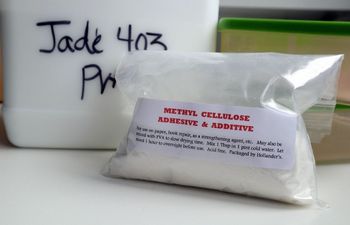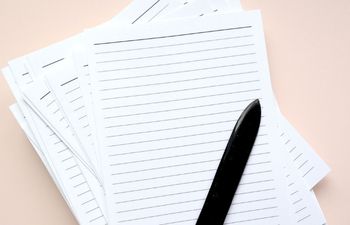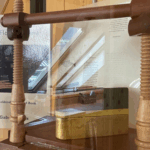Warning – this post has way more info on thread than you may ever want to read in your life, but it’s worth it! Today, I’ll break down some bookbinding thread basics and explain how to choose the right thread for your next book.
Thread has various properties that make it suitable or unsuitable for use in bookbinding. You might notice these when shopping online or in stores, so it’s good to have a basic understanding of what they are. I’ll also show you how these properties can impact your book in positive or negative ways.
Thread properties
First up, a bit of thread lingo. Don’t memorize this, just look back if you need to while reading.
- Type (raw material): Flax, cotton, nylon, etc. This is the raw material used to make individual strings. Linen thread is considered one of the strongest and is the preferred type by bookbinders all over the world.
- Strand: Finished string of material such as flax, cotton, nylon, etc. which is ready to be used individually or woven together.
- Ply (# of strands): The number of strands woven together to create thread.
- Gauge (thickness): Thickness (in millimeters) of finished thread. Sometimes called the “lea” value.
- Dyed/Natural: Refers to whether or not the natural plant fibers have been dyed a specific color, such as red.
- Bleached/Unbleached: Has no bearing on performance of thread. Instead, refers to whether or not the natural plant fibers have been bleached to white or left unbleached for a natural look.
- Waxed/Unwaxed: Refers to whether or not wax has been added to thread. Wax reduces the tendency for smaller gauge threads to tangle when sewing while also protecting the paper from tears. Machine waxed thread is generally always thicker than hand-waxed thread.
Why these properties matter
Well, there’s this thing called spine “swell.”
Swell refers to the thickening of a book’s spine as a result of sewing thread into signatures.
Okay, so most of us want our books to have that “perfect” look where the front and back covers are a slick 90 degrees to the spine. It’s tough to get this look if the spine is bloated like your Dad after Thanksgiving dinner.

A spine with too much swell can make the text block tough to handle and too little swell can make it hard to get some bindings to look right. So, what is the “right” amount of swell?
There’s a lot of little things that go into swell, but thread is a great place to start because we have lots of control over what we use.
Thread notation – X/Y
When buying thread, you’ll probably see some numbers that look like this: 12/3. These numbers are just the gauge and ply of the thread. So, X/Y = GAUGE/PLY.
- X, the first number: This is the gauge (thickness) of the thread. The smaller the number, the thicker the thread.
- Y, the second number: This is the ply (number of strands woven together). The larger the number, the thicker the thread because there are more strands.

Quiz: Which is the thicker thread?
12/3 or 18/4
If you chose “18/4”, you’re right! This is because there are 4 total strands woven together (18/4) whereas the first option only has 3 strands woven together (12/3). More strands = higher ply = thicker thread.
Example Scenarios
Okay, now that we know about gauge/ply and spine swell, it’s time to pick out your thread!
A couple questions I usually ask myself:
- Closed vs. exposed spine sewing – will the spine of the book be closed (as in a casebinding) or exposed (as in a coptic or long stitch binding)?
A closed spine usually needs a smaller gauge thread, because it will be backed and covered. An exposed spine sewing usually needs a thicker thread because it helps to provide support. - Text weight or cover weight papers – will this book use a thicker art paper for sketching or a text weight paper for writing?
Heavy paper can absorb thicker thread better than a lighter text weight paper.
Scenario #1:
If you plan to create a coptic (long stitch) binding with an exposed spine for a new art journal, it would make the most sense to try either 12/3 or 18/3 thread.
Scenario #2:
If you plan to create a hardback casebinding for use as a journal, it would make the most sense to try either 25/3 or 30/3 thread.
Scenario #3:
If you plan to create a Japanese stab binding for use as a sketch book, it would make sense to try either 18/3 thread or 25/3 thread because it’s a good idea to wax the thread for this style.
Common thread sizes used in bookbinding
To make all of this super easy, I made a chart. These are the most common threads used in books.
| Gauge | Ply | Diameter (mm) |
|---|---|---|
| 35 | 3 | 0.40 |
| 30 | 3 | 0.45 |
| 25 | 3 | 0.50 |
| 18 | 3 | 0.60 |
| 12 | 3 | 1.0 |
You’ll notice lots of 3-ply thread. This is because 3-ply is a great all-around size for many bindings.

Important technical stuff: if you want to buy commercially waxed linen thread, just know the gauge (diameter) will be larger than what is listed above because machines wax each individual strand before they’re woven into thread, adding thickness.
The thing to know about thread is this: use what works for you. Try embroidery thread or a regular spool from Joanne’s. Don’t overthink it! Just sew!
More bookbinding goodness
✨ What tools do I need to get started bookbinding?
- Bookbinding Tools & Supplies Quick Start Guide – learn all about book making tools, which to buy first & where to go online
- Pick up my popular Complete Starter Bookbinding Tools Kit – all the bookbinding essentials in one spot
🌟 Looking for a simple way to start making books?
Try a Complete Book Materials Kit. Each one has everything you need (+ tutorials & videos) to make a beautiful book without all the fuss.
Thank you for taking me along on your book making journey!
Misty












